by Jill & Sarah | Feb 8, 2019 | In The Loop
History & Geography

Greek Chorus takes a bow
We wrapped up our Greek unit this short week with a review on Thursday. We played Jeopardy, answering questions about Ancient Greece and read through our Greek packet. Fable groups practice reading and acting out their plays. On Friday we celebrated with our Greek day. We had fun participating in a mini Olympics, trading goods at the Agora, and performing our fables for the 3rd and 4th grade class. Next week we will begin our American Constitution unit.
Our objectives:
• review what we have covered in our Ancient Greek lessons
• finish any unfinished work in our Greek packet
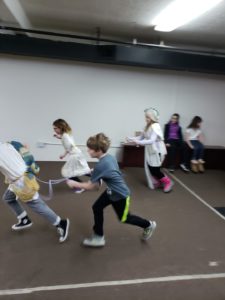
Chariot races at the Olympics
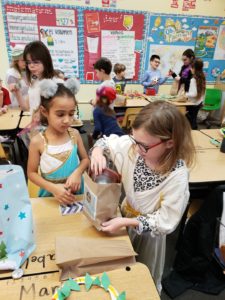
Trading goods at the agora
Science
On Thursday we finished reading about social insects; ants and termites. We worked in our insect journals and wrote about how termites and ants work together in a community. We began to discuss our upcoming insect report. Students are thinking about what specific insect they would like to report on and make a model of. I will send more information on this project in an email on Monday so students can work on it at home if we miss school next week due to snow.
Our objectives were to:
• explain that insects are the largest group of animals on Earth
• explain that there are many varieties of insects
• distinguish between social and solitary insects
• describe how all members of a social insect colony come from one queen
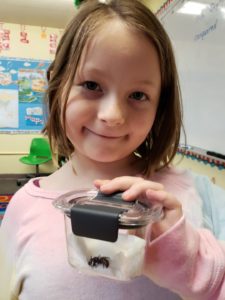
We are going buggy for insects!
• describe the social behavior of ants and ant colonies
• describe the roles of worker ants, males, and queens
English Spelling and Writing
In our journals we used the idiom of the week, she is hitting the books. The class got their new sort list but we won’t be taking the practice test until Monday due to the short school week. Our Word Wall words was: people
La lectura
This week we began learning about Black History Month.
Our weekly objectives were to:
- read about famous Black Americans including Martin Luther King Jr,, Jackie Robinson, Thurgood Marshall, and Ruby Bridges
- create a Black History Month Booklet with facts about each person we read about
Las matemáticas
Our weekly objectives were to begin learning about Money:
- review how to say each coin in Spanish
- understand how to write coins using the cents symbol and the dollar symbol
- learn about bills and how to say them in Spanish
- understand how to write bills using the cents symbol and the dollar symbol
Have students practice exchanging coins and bills at home for extra practice. Remember that Prodigy is a great resource to keep those math skills sharp, in case of a few snowy days.
by Sarah Segall | Feb 8, 2019 | In The Loop
La lectura and Las matemáticas
With our short week we still tried to get in as much learning as possible!
Our weekly objectives were to:
- Read syllables with “a”, create words and sentences with syllable “a” words.
- Write in our journal about our favorite thing to do on a snowy day (we read the classic Snowy Day).
- Use uppercase letters when starting a sentence and when using names.
- Use a period or an exclamation point when needed at the end of a sentence.
- Practice subtraction and addition on the number line.
- Create number families with all numbers up to 10.
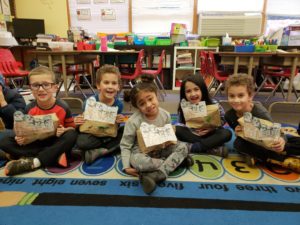 History & Geography
History & Geography
In our studies of the presidents of the United States this week we learned about Mount Rushmore. We read our lesson and watched an interesting video about the making of this national monument. Did you know their is a secret room in the Mountain? We had fun finding out all kinds of information. The class then did an art activity to go along with the lesson. This wraps up our unit. Next week we will review and take our assessment.
Our objectives were to:
• understand what a monument is
• describe the making of Mount Rushmore and identify who created it
• identify the Mount Rushmore presidents
• describe Mount Rushmore as a monument
Science
We finished our unit, Seasons and Weather, this week with a lesson on meteorology. Because of our crazy weather the last few days this was a perfect lesson for the week and gave us great examples of how weather predictions are important to our lives. Afterwards the kiddos had fun creating their own weather reports and performing them for the class. On Friday we had some fun weather experiments in jars. We created a snowstorm, clouds, and rain. Next week we
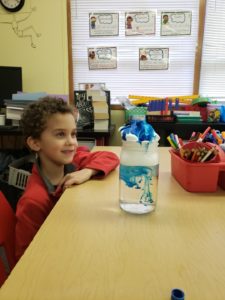
Making it rain!
will be reviewing and taking the assessment for this unit.
Our objectives were to:
• identify ways in which weather affects daily routines, such as dress, activities, etc
• understand why weather prediction is important in daily lives
• explain the role of a meteorologist
• understand the roll satellites play in a meteorologist’s job
by Sarah Segall | Feb 6, 2019 | In The Loop
Spanish With Sarah will have a 2-hour late start due to inclement weather and unsafe road conditions today, Wednesday February 6th.
There will be no AM preschool.
The early-release Wednesday schedule is cancelled. All K-6 classes will now be released at 3:15.
Here is our schedule for our specialist classes for the day:
class 1 10:45-11:45
modified lunch/recess 11:45-12:30
class 2 12:30-1:25
class 3 1:25-2:20
class 4 2:20-3:15
by Sarah Segall | Feb 5, 2019 | In The Loop
SNOW DAY #2
There will be no classes held today at Spanish With Sarah due to the inclement weather.
by Sarah Segall | Feb 5, 2019 | In The Loop
Tomorrow, February 5th, Spanish With Sarah classes will begin two hours late due to inclement weather.
There will be no AM preschool on 2-hour late start days.
by Sarah Segall | Feb 4, 2019 | In The Loop, Preschool
Spanish With Sarah is closed due to inclement weather.
Monday, February 4th.
https://flashalert.net/id/SpanishWithSarah
by Sarah Segall | Feb 2, 2019 | In The Loop
The weather has been really mild this year! However, the forecast is looking questionable for the next week or so. Here’s a reminder on how to stay informed of school delays or cancellations:
We do follow the Camas School District when they choose to have 1-hour and 2-hour late starts and school closures due to inclement weather.
There will be no AM preschool if there is a 2-hour late start.
We will also post this information on the school Facebook page,
In the Loop on the SWS website,
and we will also send out a mass email.
Please be sure to check before you leave home so you don’t trek through unsafe road conditions! Remember, Camas has high elevations that may be unsafe even when things appear fine at your house.
by Ivary & Paola | Feb 1, 2019 | In The Loop
La Lectura
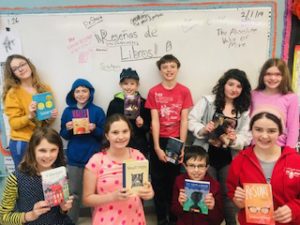 !Celebrado la lectura! This week we celebrated our love for reading (and writing;) by sharing with the class our book reviews. Make sure you ask your child to show you the great pieces they, and their classmates, wrote produced. We have all added some great titles to our reading lists! This week we also continued learning about the life of one of the greatest Latin American writers, Gabriel Garcia Marquez. Since our genre studies focus was biographies, we read about his upbringing and experiences that inspired him to become one of the greatest of Spanish literature. Other objectives included:
!Celebrado la lectura! This week we celebrated our love for reading (and writing;) by sharing with the class our book reviews. Make sure you ask your child to show you the great pieces they, and their classmates, wrote produced. We have all added some great titles to our reading lists! This week we also continued learning about the life of one of the greatest Latin American writers, Gabriel Garcia Marquez. Since our genre studies focus was biographies, we read about his upbringing and experiences that inspired him to become one of the greatest of Spanish literature. Other objectives included:
• Pose and respond to specific questions with elaboration and detail by making comments that contribute to the topic, text, or issue under discussion.
• Cite textual evidence to support analysis of what the text says explicitly as well as inferences drawn from the text.
• Determine a theme or central idea of a text and how it is conveyed through particular details; provide a summary of the text distinct from personal opinions or judgments.
• Analyze in detail how a key individual, event, or idea is introduced, illustrated, and elaborated in a text (e.g., through examples or anecdotes).
• Apply a variety of comprehension and thinking skills while unpacking information from the text (this week’s focus: cause and effect situations)
• Review key characteristics of our genre studies for this week: Biographies.
• With some guidance and support from peers and adults, develop and strengthen writing as needed: final copy, publishing and sharing.
Ciencias
- Explain how adaptations help organisms survive in an environment.
- Describe how population can change over time in response to environmental factors.
Mathematics
This week we wrapped up our unit on algebraic expressions. Our objectives were:
•create and solve expressions from real world problems
•review for the chapter test by completing a classroom Brain Work question
•show what you know on the chapter test
History & Geography
This week we continued learning about the French Revolution. Our objectives were:
•Identify Marie Antoinette and describe her effect on the French people.
•Explain the meaning behind the legendary saying, “then let them eat cake.”
•Describe what happened at the 1789 meeting of the Estates-General.
•Understand Louis XVI’s role in the meeting.
•Understand how the National Assembly came into existence.
Reminder that our field trip to the Pendleton Mill is Thursday February 7th! We will be meeting there at 9 am.
English Writing & Spelling
This week we studied the Greek and Latin roots onym, host, hosp. All these roots have something to do with people!
We also worked on building a conclusion in our argumentative writing.
Specialists
Music with Ms. Erin
In January we learned the Italian terms for tempos from grave (very, very slow), to prestissimo (extremely fast). We practiced rhythm reading by clapping written rhythm patterns to these tempos. We learned about musical form, adding introduction, interlude, and coda to our knowledge base of verse, chorus (refrain), and bridge. We also started learning about Harlem Renaissance music.
In February we will be working on reading notation in the treble and bass clefs, and introducing the skill of sight singing. We will identify, write, read, sing, and play music from written notation using a variety of musical styles. We will learn about jazz, continuing our study of the Harlem Renaissance, by using lead sheets and singing popular jazz songs.
Art with Ms. Kelly
We worked on 2 projects in January:
Art Project: Cakes in the style of Wayne Thiebaud
Book and Website: Artwork by Wayne Thiebaud
Goals:
- Learn about the artist, Wayne Thiebaud (who is still painting at age 98!)
- Observe light and dark shapes, and shadows
- Draw a cylinder with a wedge cut out
- Use oil pastels to create shading and shadows
I’m sure you’ve enjoyed these beautiful cakes on the bulletin board at school!
Art Project: Figures in the style of Jacob Lawrence
Books: Jake Makes a World by Sharifa Rhodes-Pitt,
Story Painter: The Life of Jacob Lawrence
Goals:
- Learn about Jacob Lawrence, an African American artist
- (who grew up in Harlem but moved to Seattle and taught art at University of Washington)
- Use basic shapes to draw students at the blackboard
- Use tempera paint for the background and figures in your artwork
These awesome pictures are on the bulletin board at the end of the hallway!
by Sarah Segall | Feb 1, 2019 | In The Loop
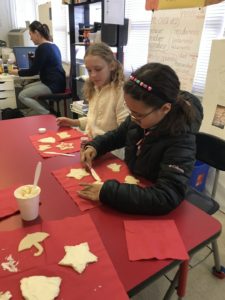
Photo credit: Kate
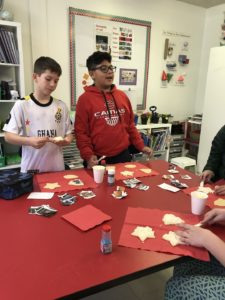

Fun celebrating the end of our Africa unit playing a game Eli designed.
History & Geography
Our weekly objectives were to:
- Understand China´s isolation and why the Chinese finally tried to break that isolation.
- Identify the reasons for the development of the Silk Road.
- Relate the idea of the Han dynasty as a golden time to cultural advances such as the invention of paper.
- Describe the social and personal pressures facing young women in ancient China.
- Identify details that reveal Changan to have been a bustling, diverse, exotic capital.
- Recognize Wu Zhaoś extraordinary rise to political power form humble beginnings.
Newsletter by Pierce:
On Monday in English we had our African celebration!
On Tuesday in Science we had to redo our test!
On Wednesday it was wackey!
On Thursday we brought our science information.
On Friday it is BINGO DAY!
Mathematics w/Laura
Adding and Subtracting Decimals
- Adding and Subtracting Decimals
- Real World Problems: Decimals
- Review and Put on Your Thinking Caps
- Chapter 8 assessment on Tuesday, February 5th
Puzzles available for extra credit and Friday (Math) Bingo
Remember: MATH …. It’s everywhere
La lectura
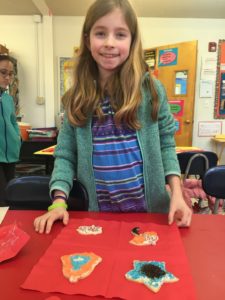 This week we read a very fun folktale: La Sal. This Russian tale is about three sons. The third son, Ivan, is called a fool but is a good, wise, and clever man. When faced with problems, Ivan does not resort to treachery or wickedness as his brothers do. By strumming sweet melodies on his mandolin, he charms a gloomy giant, woos a princess, and wins back the riches stolen from him by his two jealous brothers.
This week we read a very fun folktale: La Sal. This Russian tale is about three sons. The third son, Ivan, is called a fool but is a good, wise, and clever man. When faced with problems, Ivan does not resort to treachery or wickedness as his brothers do. By strumming sweet melodies on his mandolin, he charms a gloomy giant, woos a princess, and wins back the riches stolen from him by his two jealous brothers.
Our weekly objectives were to:
- identify the authorś point of view
- identify the common folktale moral (in this case: goodness wins over evil)
- work together to turn the story into a short skit, creating dialogue. (We will really dig into this next week.)
- identify digraphs, which are two letters that make one sound (our spelling list this week was full of digraphs- ll, rr, ch)
- review use of semicolons, colons, and other marks. (Colons are used to present a list of things, before quotation marks, and after the greeting in a letter. Semicolons are used to separate the components of a long series that contains commas. Parentheses are used around words that add information to, or clarify, a sentences. Hyphens separate some compound words.)
On Monday we celebrated a combined reading for December and January with a cookie decorating party after lunch. Yumm!!
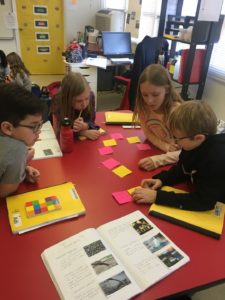
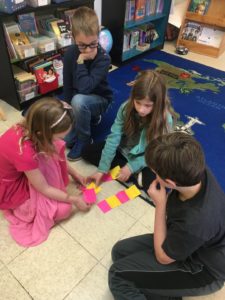 Ciencias
Ciencias
Students were given the opportunity to retake their science test (since I was absent on the day it was given). I was supposed to hand them back (but neglected to do so). They will receive them on Monday.
We began our new science topic: Natural Resources. We reviewed what we have learned about soils, rocks, and landforms. Students worked in groups to create a concept map to bring these ideas together. We focused on earth materials as renewable and nonrenewable natural resources by viewing and discussing a video.
We also read, as a whole class, about monuments around the world. It was interesting to compare and contrast theses 4 monuments in a graphic organizer. The Washington Memorial, The Vietnam Veterans Memorial, The Taj Mahal, The Great Pyramid. What were they made out of? Who were they made for? How long did construction take?
Our focus question this week was: What are natural resources and what is important to know about them?
Specialists:
Music with Ms. Erin
In January we learned about musical form; verse, chorus (refrain), introduction, and coda. We learned about theme and variations by studying the music of W. A. Mozart, J. S. Bach, and Liszt’s variations on a theme by Paganini.
In February we will be working on reading notation in the treble and bass clefs, and introducing the skill of sight singing. We will identify, write, read, sing, and play music from written notation using a variety of musical styles. We will learn about jazz and the Harlem Renaissance, while being introduced to jazz “lead sheets”.
Art with Ms. Kelly
We worked on 2 projects in January:
Art Project: Cakes in the style of Wayne Thiebaud
Book and Website: Artwork by Wayne Thiebaud
Goals:
- Learn about the artist, Wayne Thiebaud (who is still painting at age 98!)
- Observe light and dark shapes, and shadows
- Draw a cylinder with a wedge cut out
- Use oil pastels to create shading and shadows
I’m sure you’ve enjoyed these beautiful cakes on the bulletin board at school!
Art Project: Figures in the style of Jacob Lawrence
Book: Jacob Lawrence
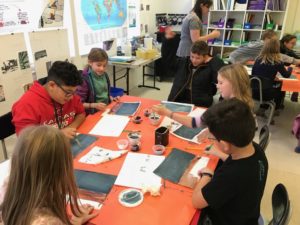 Goals:
Goals:
- Learn about Jacob Lawrence, an African American artist
- (who grew up in Harlem but moved to Seattle and taught art at University of Washington)
- Use basic shapes to draw students at the blackboard
- Use tempera paint for the background and figures in your artwork
We are still working on this project, and I plan to display them on a bulletin board in February.















